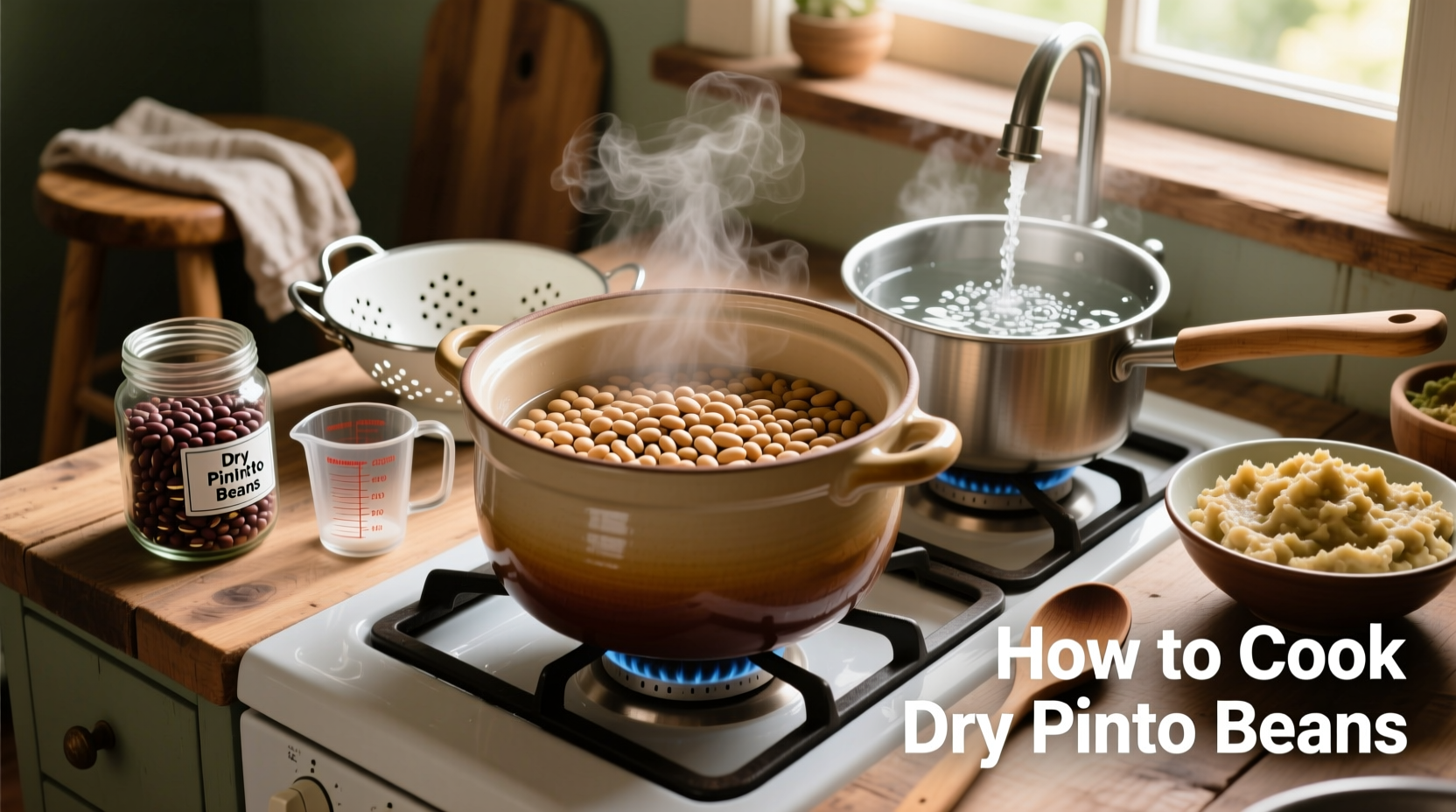Discover the perfect method to transform humble dry pinto beans into creamy, flavorful staples for your favorite dishes. This comprehensive guide reveals professional techniques that guarantee consistently tender beans every time—without the preservatives and excess sodium of canned varieties.
Why Cook Dry Pinto Beans From Scratch
Cooking dry pinto beans offers significant advantages over canned alternatives. You'll save up to 60% compared to premium canned beans while gaining complete control over texture and sodium content. Properly cooked dry beans develop a richer, more complex flavor profile and maintain structural integrity better in dishes like refried beans or stews.
Essential Equipment and Ingredients
You'll need just a few basic kitchen items:
- Large pot with tight-fitting lid (6-quart minimum)
- Fine-mesh strainer
- Measuring cups
- Wooden spoon
For one pound (2 cups) of dry pinto beans, gather:
- 2 cups dry pinto beans
- 6 cups fresh water (plus more for soaking)
- 1 bay leaf (optional)
- 1 teaspoon cumin seeds (optional)
- 2 cloves garlic, smashed
Step-by-Step Cooking Process
Preparation: Sorting and Rinsing
Spread beans on a light-colored surface to inspect for debris or damaged beans. Discard any discolored or shriveled specimens. Rinse thoroughly under cold running water in a fine-mesh strainer, removing any floating particles.
Soaking Methods Compared
| Method | Time Required | Water Ratio | Best For |
|---|---|---|---|
| Overnight Soak | 8-12 hours | 3:1 (water:beans) | Traditional cooking, best texture |
| Quick Hot Soak | 1.5 hours | 3:1 (water:beans) | Same-day cooking needs |
| No-Soak Method | 2.5-3 hours | 4:1 (water:beans) | Emergency situations only |
Overnight Soak Method (Recommended)
Place sorted beans in a large bowl and cover with 3 inches of cold water. Let soak at room temperature for 8-12 hours. Drain and rinse before cooking.
Quick Hot Soak Method
Place beans in pot, cover with 3 cups water per 1 cup beans. Bring to rapid boil for 1 minute. Remove from heat, cover, and let stand for 1 hour. Drain and rinse.
Cooking Timeline for Perfect Texture
0-15 minutes: Combine soaked beans with fresh water (3:1 ratio), garlic, and bay leaf. Bring to gentle boil.
15-30 minutes: Reduce to simmer, skim foam that forms on surface.
30-90 minutes: Maintain steady simmer (bubbles breaking surface gently).
90-120 minutes: Test beans for tenderness every 15 minutes.
When tender: Add salt and seasonings, cook 10 more minutes.

Critical Cooking Tips
Avoid these common mistakes that ruin bean texture:
- Never add salt or acidic ingredients (tomatoes, vinegar) until beans are fully tender—this prevents proper softening
- Maintain consistent gentle simmer—vigorous boiling breaks beans apart
- Keep water level 2 inches above beans throughout cooking, adding hot water as needed
- Test doneness by blowing on a few beans—they should feel uniformly soft with no chalky center
Troubleshooting Common Issues
Beans remain hard after cooking: This typically indicates old beans (over 1 year storage) or hard water. Try adding 1/8 teaspoon baking soda to soaking water (use sparingly as it can affect flavor).
Excessive foaming: Skim foam regularly during first 30 minutes of cooking. Adding a tablespoon of oil to cooking water reduces foaming but isn't traditional.
Beans breaking apart: Usually caused by temperature fluctuations or excessive stirring. Maintain consistent heat and handle beans gently.
Flavor Enhancement Techniques
Professional chefs time seasoning additions for maximum impact:
- Add aromatics (onion, garlic) at beginning for subtle background flavor
- Introduce dried spices (cumin, oregano) during last 30 minutes of cooking
- Add fresh herbs and acidic elements (lime juice, vinegar) after cooking
- For authentic Latin American flavor, include epazote during last 20 minutes
Nutritional Benefits and Serving Information
According to USDA FoodData Central, one cup of cooked pinto beans provides:
- 245 calories
- 15 grams of protein
- 15 grams of fiber (58% of daily value)
- Significant iron, magnesium, and folate
Properly cooked beans should maintain their shape while yielding easily when bitten. Serve immediately or store for later use.
Storage and Reheating Guidelines
Refrigerate cooked beans in their cooking liquid for up to 5 days. For longer storage:
- Portion into 1.5 cup servings (equivalent to one 15-ounce can)
- Store with 1/2 cup cooking liquid in freezer-safe containers
- Freeze for up to 6 months
Thaw overnight in refrigerator or use quick-thaw method: place sealed container in cold water for 30 minutes. Reheat gently in saucepan with reserved liquid to maintain texture.
Frequently Asked Questions
Can I cook pinto beans without soaking them?
Yes, but cooking time increases to 2.5-3 hours. Use a 4:1 water-to-bean ratio and check frequently after 2 hours. The no-soak method often produces less uniform texture compared to soaked beans.
Why do my pinto beans stay hard even after long cooking?
Hard beans usually indicate old beans (over 12 months storage) or hard water. Try adding 1/8 teaspoon baking soda to soaking water. Avoid adding salt or acidic ingredients until beans are fully tender, as these prevent softening.
When should I add salt to pinto beans?
Add salt only after beans have become tender, typically during the last 10-15 minutes of cooking. Adding salt too early can prevent proper softening and result in tough beans. Use 1-1.5 teaspoons per pound of dry beans for optimal flavor.
How can I reduce gas caused by eating beans?
To minimize digestive discomfort, change soaking water once during overnight soak, discard soaking water before cooking, and add epazote or kombu seaweed during cooking. Gradually increasing bean consumption over several weeks also improves tolerance.











 浙公网安备
33010002000092号
浙公网安备
33010002000092号 浙B2-20120091-4
浙B2-20120091-4